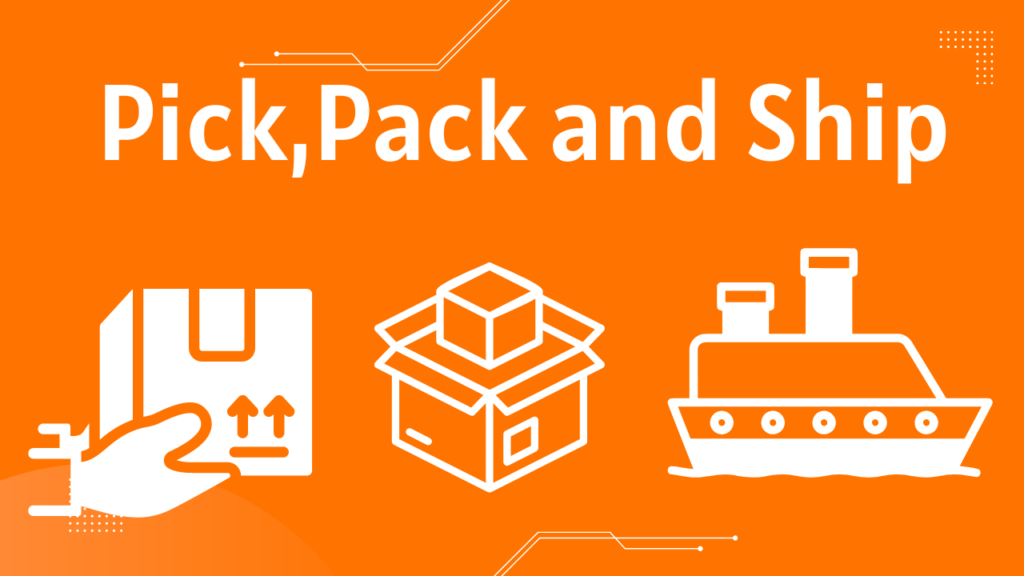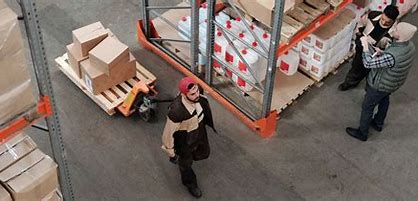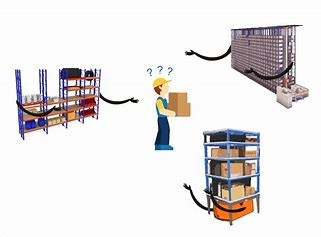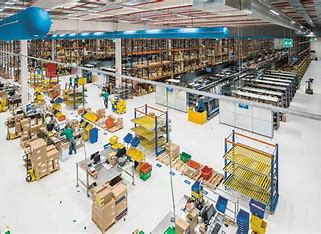Pick, pack, and ship is a process that involves the movement of goods from a warehouse to the customer. This process can be time-consuming and complicated, especially for businesses with large inventories or high volume order fulfillment needs. In this article, we’ll explore the different aspects of pick, pack, and ship processes, including picking and packing methods, automation options, workflow optimization, order tracking, provider selection, and cost management. By the end of this article, you’ll have a better understanding of what pick, pack, and ship entails, and how it can benefit your business.
What are pick, pack and ship processes?

Pick, pack, and ship processes are the backbone of any successful e-commerce business. These processes refer to the steps involved in fulfilling customer orders, from picking the items from the warehouse shelves to packing them securely and shipping them out for delivery.
The first step in the pick, pack, and ship process is picking. This involves locating the items that the customer has ordered from the warehouse shelves. In some cases, this process may involve using a paper-based system where the picker receives a printed order form and manually locates the items. In other cases, the process may be automated, with the picker using a handheld scanner or a voice-activated system to guide them to the correct location.
Once the items have been picked, they move on to the packing stage. Here, the items are carefully packed into boxes or other shipping containers, along with any necessary packing materials such as bubble wrap or packing peanuts. The packing stage is critical, as it ensures that the items arrive at the customer’s doorstep in good condition.
Finally, the items are shipped out for delivery. This involves transporting the packages to the appropriate carrier, such as UPS or FedEx, and ensuring that they are delivered to the customer’s designated location in a timely manner.
Effective pick, pack, and ship processes are essential for any e-commerce business looking to provide a positive customer experience. By streamlining these processes and ensuring that orders are fulfilled accurately and efficiently, businesses can build a loyal customer base and drive long-term growth.
Automation is becoming increasingly popular in the pick, pack, and ship process, as it can help businesses to reduce errors and increase efficiency. Automated systems can help to optimize warehouse layouts, improve inventory management, and reduce the time it takes to fulfill orders. However, even with automation, it’s important to have skilled workers on hand to oversee the process and ensure that everything runs smoothly.
Different picking and packing methods

When it comes to picking and packing goods for shipment, there are various methods that can be used depending on the nature of the business and the type of products being shipped. Let’s take a closer look at some of the most common methods.
Picking Methods

Single Order Picking: This method involves picking one order at a time. It is a straightforward approach that works well for smaller operations with a low volume of orders. Single order picking is ideal for businesses that specialize in customized or personalized products. This method ensures that each order is accurate and tailored to the customer’s specific requirements.
Batch Picking: Batch picking is a method that involves picking multiple orders at once. This approach is more efficient than single order picking, as it allows pickers to fulfill several orders simultaneously. Batch picking is ideal for businesses that have a high volume of orders and need to process them quickly. However, it can be challenging to ensure accuracy, as there is a higher risk of mix-ups and errors.
Zone Picking: This method involves dividing the warehouse into specific zones and assigning pickers to each zone. Each picker is responsible for picking items from their designated zone. Zone picking is an efficient method that allows businesses to process a high volume of orders quickly. It is ideal for businesses that have a large warehouse and a high volume of orders. However, it can be challenging to manage and coordinate multiple pickers.
Packing Methods

Bulk Packing: This method involves packing multiple items into a single box or container. Bulk packing is an efficient method that saves time and reduces shipping costs. It is ideal for businesses that sell products in large quantities, such as wholesalers or distributors. However, it may not be suitable for businesses that sell fragile or delicate items.
Individual Packing: This method involves packing each item separately. Individual packing is ideal for businesses that sell fragile or delicate items that require extra care and protection during shipping. However, it can be time-consuming and may increase shipping costs.
Gift Wrapping: This method involves wrapping items in gift paper or packaging. Gift wrapping is ideal for businesses that sell gift items or products that are intended as gifts. It adds a personal touch and enhances the customer’s experience. However, it can be time-consuming and may require additional materials and labor.
Ultimately, the best picking and packing methods depend on the nature of the business, the type of products being shipped, and the customers’ expectations. By choosing the right methods, businesses can ensure that their orders are accurate, efficient, and cost-effective.
Also checkout importance’s of the Pallet Storage Pricing
What is the difference between picking, packing, and shipping?

When it comes to fulfilling orders, there are three crucial steps that make up the pick, pack, and ship process. These steps are picking, packing, and shipping, and they each play a critical role in ensuring that customers receive their orders accurately and efficiently.
Picking
Picking is the first step in the pick, pack, and ship process. It involves retrieving goods from inventory and preparing them for the next stage of the process. Picking can be done manually or with the help of technology, such as barcode scanners or pick-to-light systems.
During the picking process, it’s essential to ensure that the correct items are selected and that they are in good condition. This is especially important for items that are fragile or have specific storage requirements. Picking errors can lead to delays, customer dissatisfaction, and increased costs, so it’s crucial to have a reliable and accurate picking process in place.
Packing
Packing is the second step in the pick, pack, and ship process. It involves assembling goods into shipments and preparing them for transport. Packing can also be done manually or with the help of technology, such as automated packing machines or packing software.
During the packing process, it’s important to ensure that the goods are packed securely and efficiently. This can help to prevent damage during transport and reduce the risk of returns or exchanges. It’s also important to ensure that the correct shipping labels and documentation are included with each shipment.
Shipping
Shipping is the final step in the pick, pack, and ship process. It involves transporting goods to the customer or their designated location. Shipping can be done using a variety of methods, such as ground, air, or sea transport.
During the shipping process, it’s important to ensure that the goods are delivered on time and in good condition. This can help to build customer trust and loyalty and can also help to reduce costs associated with returns and exchanges.
In conclusion, the pick, pack, and ship process is a crucial part of any order fulfillment operation. Understanding the differences between picking, packing, and shipping can help to ensure that each step is performed accurately and efficiently, resulting in satisfied customers and a successful business.
Automating the Pick, Pack, and Ship Process

As e-commerce continues to grow, businesses must find ways to keep up with the increasing demand for fast and accurate order fulfillment. One solution that has gained popularity in recent years is the use of automation technology to streamline the pick, pack, and ship process.
Basic automation solutions, such as conveyor systems and barcode scanners, can help reduce the time and labor required to fulfill orders. These systems can quickly and efficiently move products from one location to another, reducing the need for manual handling and minimizing the risk of errors.
For businesses with higher order volumes, more advanced automation solutions may be necessary. Robotics and AI-driven systems can help increase throughput and accuracy, further reducing the need for human intervention. These systems can also be programmed to handle a wide range of products, making them a versatile solution for businesses with diverse product offerings.
While automation can be a valuable investment for businesses looking to improve their order fulfillment processes, it is important to carefully consider the costs and benefits before making a decision. Upfront investment costs can be significant, and ongoing maintenance and training may also be required. However, the long-term benefits of increased efficiency and accuracy can ultimately lead to significant cost savings and improved customer satisfaction.
In addition to the direct benefits of automation, businesses may also see indirect benefits such as improved inventory management and better use of warehouse space. By reducing the time and labor required for order fulfillment, businesses can free up resources to focus on other areas of their operations, such as marketing and product development.
Overall, automation can be a valuable tool for businesses looking to stay competitive in the rapidly growing e-commerce market. By carefully evaluating the costs and benefits and choosing the right automation solution for their needs, businesses can improve their order fulfillment processes and position themselves for long-term success.
Optimizing Your Pick, Pack, and Ship Workflow

An optimized pick, pack, and ship workflow can help businesses increase efficiency, reduce errors, and improve customer satisfaction. Workflow optimization involves analyzing the current processes, identifying bottlenecks and inefficiencies, and implementing changes that streamline operations. Some optimization strategies include using lean principles, implementing quality control measures, creating better layout and organization of the warehouse, and using technology solutions like Warehouse Management Systems (WMS).
Keeping Track of Pick, Pack, and Ship Orders
Tracking orders is critical for businesses to ensure that customers receive their orders on time and to manage inventory levels. Order tracking involves monitoring the movement of goods from the moment they leave the warehouse until they reach the customer. Tracking systems can be manual or automated and can range from simple order status updates to real-time shipment tracking and alerts. Effective order tracking can help businesses reduce errors, improve communication with customers, and provide better insights into the performance of the pick, pack, and ship process.
Choosing the Right Pick, Pack, and Ship Provider
The selection of the right pick, pack, and ship provider can significantly impact the success of a business’s operations. When selecting a provider, businesses should consider factors such as shipping speed and reliability, order accuracy, customer service, pricing, technology solutions, and scalability. A quality provider can offer businesses the peace of mind that the customer will receive their orders on time and in excellent condition, while also delivering cost savings and operational efficiencies.
Managing Costs with Pick, Pack, and Ship Services

The cost of pick, pack, and ship services can add up, especially for businesses with high order volume or complex fulfillment requirements. However, there are several strategies that businesses can use to manage costs, reduce waste, and improve efficiency. Examples of cost management strategies include optimizing warehouse layout and organization, using automation solutions, negotiating rates with providers, and implementing lean principles to reduce waste and unnecessary expenses. Effective cost management can help businesses improve profitability and make investments in growth and expansion.
Conclusion
Pick, pack, and ship is a critical step in the order fulfillment process for businesses of all sizes. Understanding the different aspects of this process, including picking and packing methods, automation options, workflow optimization, order tracking, provider selection, and cost management, can help businesses improve efficiency, reduce errors, and ultimately provide better service to their customers. By investing in the right strategies and solutions, businesses can streamline their pick, pack, and ship processes and achieve long-term success.
